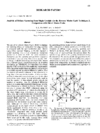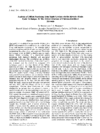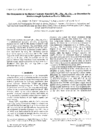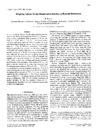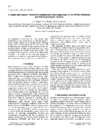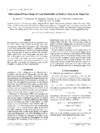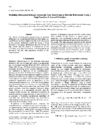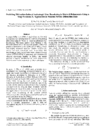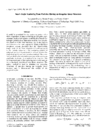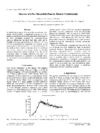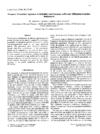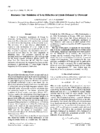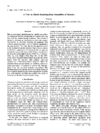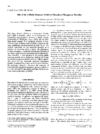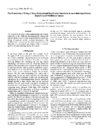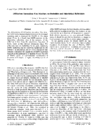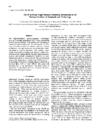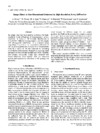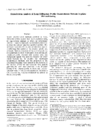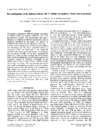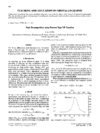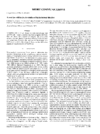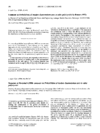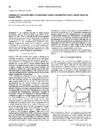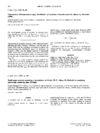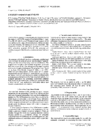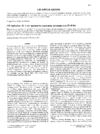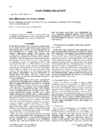issue contents
June 1998 issue

Cover illustration: Powder diffraction pattern of LaB6 obtained using a 200 x 400 mm flat imaging plate mounted at an angle of 45 degrees with the incoming X-ray beam. Experimental conditions: lambda = 0.8884 angstroms, D0 = 104 mm, exposure time 60 s. Courtesy of Poul Norby.
research papers
We compare the use of the reverse Monte Carlo (RMC) technique for analysing diffuse scattering data from single crystals with the well established direct Monte Carlo (MC) method. We further describe attempts to use RMC to obtain short-range correlation information for a relatively simple real physical system, the Tl cation distribution in TlSbOGeO4.
We report the results of an attempt to use reverse Monte Carlo (RMC) refinement to fit a model structure to the diffuse X-ray and neutron scattering of the complex defect structure of calcium-stabilized zirconia (Ca-CSZ), composition Zr0.85- Ca0.15O1.85.
The problem of determining the mixed occupancies of two crystallographic sites by four types of atom was solved by using the powder diffraction contrast produced by anomalous dispersion effects.
A new weighting scheme for the minimization function used in the Rietveld method for structure refinement using powder diffraction data is proposed. It significantly improved the accuracy of positional parameters of test samples.
An apparatus is described for simultaneous high-temperature X-ray powder diffraction and thermogravimetric studies, based on a Guinier–Lenné focusing powder camera and an analytical chemical balance. The technique is illustrated by a study of the dehydration reactions in an artists' plaster containing gypsum.
Asymmetry and its reversal of the transmitted rocking curves in the Bragg case were measured for GaAs 600 below the Ga K absorption edge. The reversal was caused by the phase change of X-ray polarizability.
The theory of dislocation-induced X-ray or neutron diffraction line broadening developed by Krivoglaz et al. and Wilkens has been adapted for Rietveld refinement of the powder diffraction profile by fitting a Voigt function to each peak.
The approach to the problem of modelling dislocation-induced X-ray or neutron-diffraction-line broadening developed in the previous paper is applied to the Rietveld refinement of the neutron powder diffraction profiles of deuterium-cycled LaNi5 and β-PdD0.66.
The small-angle scattering pattern of spherical particles having an inner structure composed of two randomly dispersed phases is derived. It is given as a sum of two functions: the scattering from isotropic particles of average density and a contribution of the inner inhomogeneities described by a single characteristic length.
Boron powder, supplied as amorphous, was found to have a significant proportion of well crystallized particles. Examination of the crystalline particles by convergent-beam electron diffraction revealed that they had a previously unreported orthorhombic crystal structure that was determined as Pnma (a = 16.7, b = 17.7 and c = 10.3 Å).
The powder refinement of a population of simulated noisy patterns samples the frequency distribution of structural parameters and gives their statistical estimators (mean, dispersion, correlations).
A theory of frequency modulation of X-rays by ultrasound during dynamical diffraction in crystals is presented.
The scattered intensity distribution from particle assemblies is related to the Fourier transform of the area fraction; by modifying the scattering density distribution in the particles, the deconvolution procedure used for obtaining the structure factor can be simplified.
A pyrolusite/ramsdellite intergrowth model is tested by fitting it to measured powder X-ray diffraction patterns of manganese dioxide. The model describes the structure of the investigated chemically prepared manganese dioxide well, but not the structure of the electrolytically prepared one.
Tests have demonstrated the practicality of using a three- dimensional fast Fourier transform calculation as the basis of an auto-indexing method for single protein crystal oscillation images.
The speed and accuracy of measuring electric-field-induced changes in diffracted intensities has been improved by two orders of magnitude. This is done by combining broad-energy-band optics with lock-on detection techniques.
The phenomenon of diffraction anomalous fine structure (DAFS) has been examined in relation to structural symmetry, and the role of DAFS signals is discussed with respect to highly absorbing crystals of finite size.
The design, performance and modes of operation of two 30 m small-angle neutron scattering instruments at the NIST Center for Neutron Research are described.
An image plate has been used as a detector for high-resolution X-ray diffraction of semiconductor heterostructures.
An eigen-system analysis has been used to investigate ill- conditioning in various deconvolution methods applied to X-ray profiles. Terms that contribtue to the ill-conditioning of the solution profile are quantifed.
By comparison of experimental data with theoretical considerations, it has been shown that most of the epitaxic orientation relationships for the `III–V nitrides on sapphire' system can be explained in terms of symmetrical analysis and Monte Carlo simulation of orientation distributions of primary nuclei.
teaching and education
Free 

An X-ray diffraction peak-decomposition procedure using a Pearson type VII function is described and implemented in a Microsoft Excel spreadsheet to aid a beginning student of X-ray diffraction.
Free 

An interactive tool for investigation of the real-space/reciprocal-space relationship in arbitrary two-dimensional crystal structures has been developed for teaching.
short communications
The design of a reaction cell for in situ studies of hydrothermal titration and ion-exchange reactions is presented.
Comments are made on a paper by Humbert, Gey, Muller & Esling [J. Appl. Cryst. (1996), 29, 662-666]. Some inaccuracies in the formal approach to the calculation of the mean orientation are indicated.
See also Response to this Comment [J. Appl. Cryst. (1998). 31, 485].
The authors had published two methods to compute the mean orientation from a cloud of orientations, as the problem practically arises when measuring individual orientations [Humbert, Gey, Muller & Esling (1996). J. Appl. Cryst. 29, 662-666]. This response recalls and outlines the main differences between their practical appproach and the more general mathematical problem exposed by Morawiec in his comments [Morawiec (1998). J. Appl. Cryst. 31, 484].
Comments are made on a paper by Basson [J. Appl. Cryst. (1997), 30, 102-106]. Some misleading conclusions concerning the distribution of disorientation axes are clarified.
See also Response to this Comment [J. Appl. Cryst. (1998).
Comments are given about a previous paper [Basson (1997). J. Appl. Cryst. 30, 102-106]. In particular, some details concerning the construction of the global distribution of disorientation axes in stereographic projection coordinates are discussed.
See also Comment to which this is a Response [J. Appl. Cryst. (1998). 31, 486].
Comments are made on a paper by Bertram [J. Appl. Cryst. (1996), 29, 682-685].
See also Response [J. Appl. Cryst. (1998), 31, 489]
This note is a response to the comments made by Pedersen [J. Appl. Cryst. (1998), 31, 488-489] on the paper Correlation effects in small-angle neutron scattering from closely packed spheres by Bertram [J. Appl. Cryst. (1996), 29, 682-685].
For crystallographic groups of rotations, the misorientation- angle distributions p(omega) given by Morawiec [J. Appl. Cryst. (1995), 28, 289-293] were already obtained by Grimmer in 1979.
computer programs
A Unix shell script has been written to control the sequential execution of different refinement operations using version 3.851 of Axel Brünger's program X-PLOR.
LAUEGEN version 6.0 is an enhanced version of the original X-Windows-based program and now enables the processing of Laue diffraction data up to and including the integration of spot intensities.
A new program to find the maximum symmetry in a molecule or a group of atoms is presented. The symmetrized coordinate and the point-group label and elements are printed out together with some parameters quantifying the deviation from the exact symmetry.
CIF applications
Free 

An object-oriented representation of a STAR file with associated applications is presented.
fast communications
A summary of many of the test crystals that have been used with single-crystal diffractometers is provided.


 journal menu
journal menu









